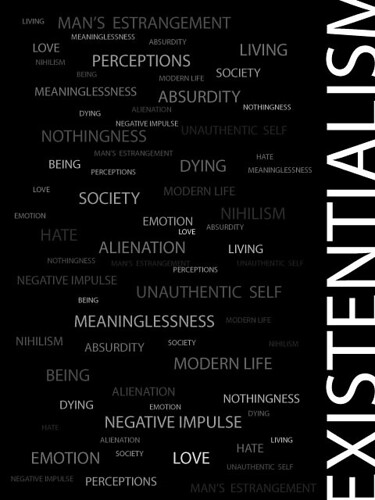This website is an unbiased outlook on certain topics and their relation to existentialism with counteracting bias comments arguing the different sides of the topic until an agreement is met.
Friday, March 9, 2012
Ruth
Was Ruth an existentialist? I just thought of this idea, and I think it's really interesting to focus on her character for a change rather than Kathy. She's interesting in that she lives a selfish life, but regrets none of it. She really just lives life down to her own ideals toward what is okay. What are your reactions?
Tuesday, March 6, 2012
Theory
The theories of existentialism include:
- The curiosity of how to live one's life and the philosophical and psychological inquiry's one has in order to enlarge the knowledge of life.
- The idea that if one wishes to live life, there will always be questions that they must deal with. These questions would include death, God, relationships, time, and one's conscience of their own self existence. Existentialism doesn't focus on "social" questions such as the politics of life and what "social" responsibility the society or state has but instead focus on the individual.
- Life is difficult, doesn't have a universal objective or value so the individual creates their own value and meaning of life and live it by not talking about it.
- Actions define values, not words.
- Existential struggles are focusing on making everyday life decisions meaningful and find that literary characterizations are the best way to make their struggles in life easier.
- One always has the right and freedom to do whatever one thinks is right.
Monday, March 5, 2012
A History of Existentialism
Existentialism was first brought forward in the early 18th century by the young French philosopher Jean-Paul Sartre. In La Nausea, Sartre’s manifesto to existentialism, he affirmed his thoughts on the theory that there is no higher being connected to the creation of the human race, but rather we are alone, fully responsible for our own actions. "We are left alone, without excuse".
From there, the theory of existentialism expanded. Philosophers brought forth their individual outlooks on the idea, expanding the definition that existentialism is “A philosophy that emphasizes the uniqueness and isolation of the individual experience in a hostile or indifferent universe, regards human existence as unexplainable, and stresses freedom of choice and responsibility for the consequences of one's acts.”
No theory has been disavowed or demoralized, but no theory has been proven as the correct answer. It all varies on the beliefs of any individual person and what they believe to be correct.
Time
Time creates an often linear line by which all human beings can measure and divide their lives. People use time to predict milestones like an infant taking its first steps or a child graduatinig middleschool. People also use time to reflect on devisions of thier lives. When I remember things, I think back on my life as I divide it into preschool, elementary school, middleschool, and currently highschool. Within each of these, I recall certain grades. I am able to remember how I acted in each grade, as if I were remembering each different person I was compared to the one I became.
In Never Let Me Go, the plot is driven by the concept of reflecting through time. Kathy, the narrator, begins her story at point 1 in the diagram below, the present day.
Kathy precedes to describe her current life, though the reader has no background to comprehend what is being said. Then, Kathy takes the reader back to her youngest years at Hailsham (2), where her earliest memories include the peculiar treatment toward all students. They were encouraged to be creative, but the reader immediately recognises that these young children have no parents and no deep connections with the adults in thier lives. The children are independent, though they have unstable identities. The plot then returns to the present day as Kathy objectively describes her friends, Ruth and Tommy.
The plot then jumps back from 1 to 3, when she lived in the "cottages" with older Hailsham students. You learn that they are infertile clones, and that they must donate their organs for use of the public health system. The students form theories about how to escape this fate, and retain their hopes. Kathy continues to struggle with her identity due to manipulative behaviors from the other students. Students like Ruth were driven to manipulate others because they are afraid. Before this section of the story ends, Kathy transitions to the present day(1).
From here, she moves forward to reach closures. This book follows a unique timeline that causes the readers to enter the story just like the children, knowing nothing. The reader finds out about the purpose of Hailsham as the characters do, but the reader has extra background of knowing what a normal life is like. The reader can feel rage at the differences in treatment, lack of escape, and purpose. The characters in the book lack this response because they know of nothing else.
This book skips around through time, but time itself provides a line through which the plot can derive some unity.
Subscribe to:
Posts (Atom)

